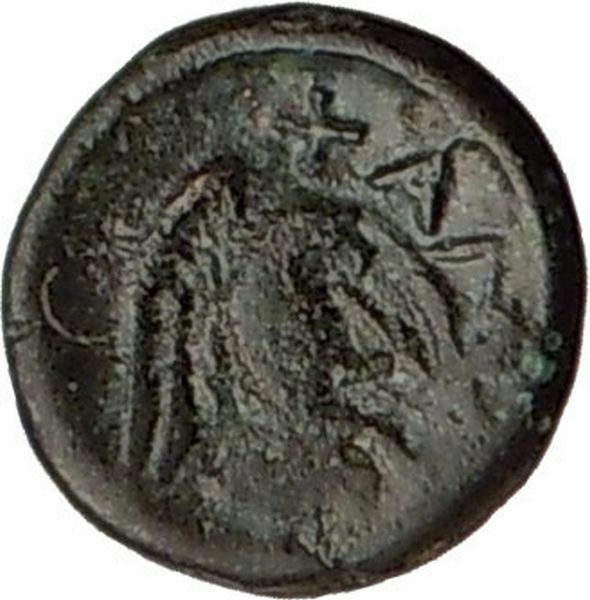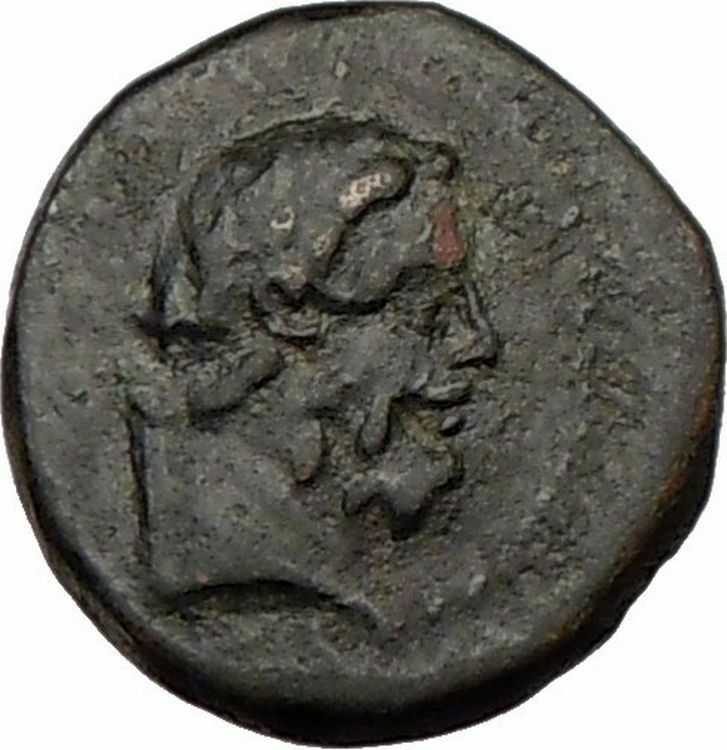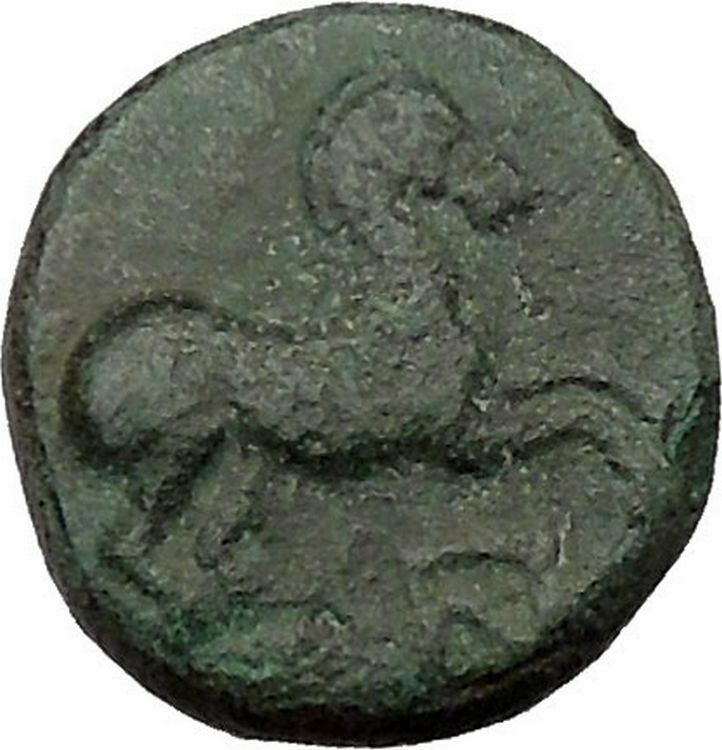|
Greek coin of
Aitolian League in
Aitolia
Bronze 18mm (4.77 grams) Struck circa 300-229 B.C.
Reference: Sear 2322 var.; HGC 4, 956
Laureate head of Aitolos or Apollo right.
AITΩ / ΛΩN above and beneath
spear-head and jaw-bone of the Calydonian boar right; bunch of grapes to
left.
The warlike people of this district produced no coinage until the 3rd Century
B.C., when
the Gallic invasion of Greece occasioned the inauguration of a
Federal currency.
You are bidding on the exact item pictured,
provided with a Certificate of Authenticity and Lifetime Guarantee of
Authenticity.
The Calydonian Boar is one of the monsters of
Greek mythology
that had to be overcome by
heroes of the Olympian age. Sent by
Artemis
to ravage the region of
Calydon
in
Aetolia
because its king failed to honor her in
his rites to the gods, it was killed in the Calydonian Hunt, in which
many male heroes took part, but also a powerful woman,
Atalanta
, who won its hide by first wounding it
with an arrow. This outraged some of the men, with tragic results.
Strabo
was under the impression that the
Calydonian Boar was an offspring of the
Crommyonian Sow
vanquished by
Theseus
.

The Calydonian Hunt shown on a Roman frieze (Ashmolean
Museum,
Oxford
)
Importance in Greek mythology and art
The Calydonian Boar is one of the
chthonic
monsters in Greek mythology, each set
in a specific locale. Sent by Artemis to ravage the region of Calydon in
Aetolia
, it met its end in the Calydonian
Hunt, in which all the heroes of the new age pressed to take part, with the
exception of Heracles
, who vanquished his own Goddess-sent
Erymanthian Boar
separately. Since the mythic
event drew together numerous heroes—among whom were many who were venerated as
progenitors of their local ruling houses among tribal groups of
Hellenes
into Classical times—the Calydonian
Boar hunt offered a natural subject in classical art, for it was redolent with
the web of myth that gathered around its protagonists on other occasions, around
their half-divine descent and their offspring. Like the quest for the
Golden Fleece
(Argonautica)
or the Trojan War
that took place the following
generation, the Calydonian Hunt is one of the nodes in which much Greek myth
comes together.

Tondo of a
Laconian
black-figure cup
by the
Naucratis Painter
, ca. 555 BCE (Louvre)
Both Homer
and
Hesiod
and their listeners were aware of the
details of this myth, but no surviving complete account exists: some
papyrus
fragments found at
Oxyrhynchus
are all that survive of
Stesichorus
‘ telling; the myth repertory called
Bibliotheke
(“The Library”) contains the
gist of the tale, and before that was compiled the Roman poet Ovid told the
story in some colorful detail in his
Metamorphoses
.
Hunt
King Oeneus
(“wine man”) of
Calydon
, an ancient city of west-central
Greece
north of the
Gulf of Patras
, held annual harvest sacrifices
to the gods on the sacred hill. One year the king forgot to include Great “Artemis
of the Golden Throne” in his offerings Insulted, Artemis, the “Lady of the Bow”,
loosed the biggest, most ferocious boar imaginable on the countryside of
Calydon. It rampaged throughout the countryside, destroying vineyards and crops,
forcing people to take refuge inside the city walls (Ovid), where they began to
starve.
Oeneus sent messengers out to look for the best hunters in Greece, offering
them the boar’s pelt and tusks as a prize.

Roman marble sarcophagus from
Vicovaro
, carved with the Calydonian Hunt (Palazzo
dei Conservatori, Rome)

Meleager et Atalanta, after
Giulio Romano
.
Among those who responded were some of the
Argonauts
, Oeneus’ own son
Meleager
, and, remarkably for the Hunt’s
eventual success, one woman— the huntress
Atalanta
, the “indomitable”, who had been
suckled by Artemis as a she-bear and raised as a huntress, a proxy for Artemis
herself (Kerenyi; Ruck and Staples). Artemis appears to have been divided in her
motives, for it was also said that she had sent the young huntress because she
knew her presence would be a source of division, and so it was: many of the men,
led by Kepheus and Ankaios, refused to hunt alongside a woman. It was the
smitten Meleager who convinced them. Nonetheless it was Atalanta who first
succeeded in wounding the boar with an arrow, although Meleager finished it off,
and offered the prize to Atalanta, who had drawn first blood. But the sons of
Thestios, who considered it disgraceful that a woman should get the trophy where
men were involved, took the skin from her, saying that it was properly theirs by
right of birth, if Meleagros chose not to accept it. Outraged by this, Meleagros
slew the sons of Thestios and again gave the skin to Atalanta (Bibliotheke).
Meleager’s mother, sister of Meleager’s slain uncles, took the fatal brand from
the chest where she had kept it (see
Meleager
) and threw it once more on the fire;
as it was consumed, Meleager died on the spot, as the Fates had foretold. Thus
Artemis achieved her revenge against King Oeneus.

Woodcut illustration for
Raphael Regius
‘s edition of
Metamorphoses
,
Venice
, ca. 1518
During the hunt, Peleus
accidentally killed his host Eurytion.
In the course of the hunt and its aftermath, many of the hunters turned upon one
another, contesting the spoils, and so the Goddess continued to be revenged (Kerenyi,
114): “But the goddess again made a great stir of anger and crying battle, over
the head of the boar and the bristling boar’s hide, between
Kouretes
and the high-hearted
Aitolians
” (Homer,
Iliad
, ix.543).
The boar’s hide that was preserved in the Temple of
Athena Alae
at
Tegea
in
Laconia
was reputedly that of the Calydonian
Boar, “rotted by age and by now altogether without bristles” by the time
Pausanias
saw it in the second century CE. He
noted that the tusks had been taken to Rome as booty from the defeated allies of
Mark Anthony
by
Augustus
; “one of the tusks of the Calydonian
boar has been broken”, Pausanias reports, “but the remaining one, having a
circumference of about half a fathom, was dedicated in the Emperor’s gardens, in
a shrine of Dionysos”. The Calydonian Hunt was the theme of the temple’s main
pediment.
Aetolus was, in
Greek mythology
, a son of
Endymion
, grandson of
Deucalion
, and a
Naiad
nymph
, or
Iphianassa
. According to
Pausanias
, his mother was called
Asterodia
,
Chromia
, or
Hyperippe
. He was married to
Pronoe
, by whom he had two sons,
Pleuron
and
Calydon
. His brothers were
Paeon
,
Epeius
, and others His father compelled him and
his two brothers Paeon and Epeius to decide by a contest at
Olympia
as to which of them was to succeed him
in his kingdom of Elis
. Epeius gained the victory, and occupied
the throne after his father, and on his demise he was succeeded by Aetolus.
During the funeral games which were celebrated in honor of
Azan
, he ran with his chariot over
Apis
, the son of
Jason
or
Salmoneus
, and killed him, whereupon he was
expelled by the sons of Apis. The kingdom then passed to
Eleius
, son of his sister
Eurycyda
. After leaving
Peloponnesus
, he went to the country of the
Curetes
, between the
Achelous
and the
Corinthian
gulf, where he slew
Dorus
,
Laodocus
, and
Polypoetes
, the sons of
Apollo
and
Phthia
, and gave to the country the name of
Aetolia
. This story is only a mythical account
of the colonization of Aetolia.
The Aetolian League (also transliterated as Aitolian
League) was a confederation of tribal communities and cities in
ancient Greece
centered on
Aetolia
in central Greece. It was established,
probably during the early Hellenistic era, in opposition to
Macedon
and the
Achaean League
. Two annual meetings were held
in
Thermika
and Panaetolika. It occupied
Delphi
from
290 BC
and gained territory steadily until, by
the end of the 3rd century BC, it controlled the whole of central Greece outside
Attica
. At its height, the league’s territory
included Locris
,
Malis
, Dolopes, part of
Thessaly
,
Phocis
, and
Acarnania
. In the latter part of its power,
certain
Mediterranean
city-states joined the Aitolian
League such as Kydonia
on
Crete
.
The Aetolians were not highly regarded by other Greeks, who considered them
to be semi-barbaric and reckless. However, their league had a complex political
and administrative structure, and their armies were easily a match for the other
Greek powers. According to Scholten, the Aetolian League consisted of elites at
the top, but was fundamentally a society of farmers and herders. The league had
a federal structure consisting of a federal council in which the level of
representation was proportional to the size of a community’s contribution to the
league’s army, a popular assembly of all citizens which met twice a year, and an
inner council equivalent to a federal government. It could raise armies and
conduct foreign policy on a common basis. It also implemented economic
standardization, levying taxes, using a common currency and adopting a uniform
system of weights and measures.
Origins of the
League
It is uncertain when the League was founded. It has been suggested that it
may have been founded by
Epaminondas
. Grainger believes it was founded
much later – around the time of the rise of
Philip II of Macedon
. After Philip’s victory of
Chaeronea
Aetolia was granted
Naupaktos
which the Aetolians garrisoned – a
level of organization that suggests some formal government rather than the loose
alliance of earlier times.
Alliance with Rome
The league was the first Greek ally of the
Roman Republic
, siding with the Romans during
the
First Macedonian War
, and helping to defeat
Philip V of Macedon
at the
Battle of Cynoscephalae
in
197 BC
, during the
Second Macedonian War
. However, it grew
increasingly hostile to Roman involvement in Greek affairs and only a few years
later sided with
Antiochus III
, the anti-Roman king of the
Seleucid Empire
, during the
Roman-Syrian War
. The defeat of Antiochus in
189 BC
robbed the league of its principal
foreign ally and made it impossible to stand alone in continued opposition to
Rome. The league was forced to sign a peace treaty with Rome that made it a
subject ally of the republic. Although it continued to exist in name, the power
of the league was broken by the treaty and it never again constituted a
significant political or military force.
A Pirate State?
The Aetolian League acquired a reputation for piracy and brigandage. Though
there is some recognition that Polybius was to an extent following an Achaean
bias in his portrayal of the League thus, many modern historians have accepted
this portrayal as in the main justified. For example, Walbank is explicit in
seeing the Aetolians as systematically using piracy to supplement their income
because of the meager resources of their region
while Will simply assumes the truth of the charge. Grainger devotes a whole
chapter to examining Aetolian involvement in piracy along with the charges that
the Aetolians were temple robbers. He finds it hard to credit that Aetolia was
involved in piracy given that Aetolia lacked a fleet of even the basic sort.
Further by contrast with more general historians, those that have made specific
studies of piracy and brigandage barely mention Aetolia. He lists the times that
the Aetolians were accused of temple robbery and argues that the weight of these
accusations should take into account that these are usually made by political
opponents of the League and refer to occasions that were already some way in the
past when the accusations were made.
|













